
While most people picture dogs as voracious eaters down for any snack, that's not always the case. In fact, it's quite common for canine companions to develop a taste for certain types of food.
This kind of behavior is more prevalent in smaller dogs, but you can also see larger breeds stick their nose up at even high-quality food.
Dogs are intelligent creatures with distinct personalities. They develop their own preferences, just like us humans do.
Oftentimes, pickiness fades and your dog will continue to eat like normal. Other times, it will stick. There are also a variety of health concerns that can affect your dog's relationship with food.
If you're dealing with a picky canine companion, it can be tough to find a food that works for them. Don't assume that the most expensive kibble on the shelf will get them jumping for joy.
To overcome picky palates, you need to delve a bit deeper into your dog's behavior and the overall quality of the food. Here are some of the best dog foods for picky eaters to get you started.
Top 5 Best-Tasting Dog Foods for Picky Eaters
1. The Honest Kitchen Human Grade Dehydrated Organic Grain Dog Food
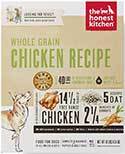
This dehydrated dog food from Honest Kitchen can please even the pickiest dogs. It's a human-grade food, so you can rest easy knowing that it has high-quality ingredients throughout.
The entire recipe is free of preservatives, GMOs, and byproducts. There are a number of formulas available. For this free-range chicken recipe, there's about 24.5 percent protein. The food is dehydrated for easy storage.
To prepare your pup's meal, all you have to do is add warm water. This process releases a tasty aroma, making it more appetizing for your dog.
2. Instinct Raw Boost Grain Free Recipe Natural Dry Dog Food by Nature's Variety
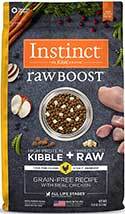
The Raw Boost, Grain-Free dog food from Instinct is a unique meal option. In addition to the kibble you're used to, it has small pieces of raw, freeze-dried chicken.
This provides a boost of protein and plenty of great flavors. The kibble is made up of high-quality ingredients all on its own. It uses chicken, turkey meal, and chicken meal. There's also chicken fat for flavor and pumpkin seeds for fiber.
The food is minimally processed to pack in the nutrients and flavor. It's also free of grains, artificial preservatives, and corn fillers.
3. Rachael Ray Nutrish Dish Natural Dry Dog Food with Veggies & Fruit
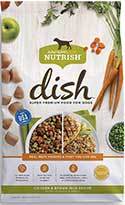
From the famed chef Rachael Ray is the Nutrish Dish dog food. This natural dog food is unique because it has healthy ingredients that you can see.
Instead of mashing every ingredient together to create a uniform piece of kibble, you can see the individual vegetables and meats. The recipe is comprised of about 26 percent protein. Most of it comes from real slow-roasted chicken.
It also has crunchy pieces of carrots, farm-raised potatoes, and peas for fiber. There are no unsavory ingredients, just natural alternatives with delicious flavor.
4. Primal Freeze-Dried Dog Food Chicken Formula
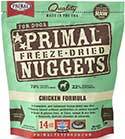
The freeze-dried dog food from Primal Pet Foods can provide your dog with a balanced diet throughout their life. It utilizes high-quality ingredients.
In terms of protein, it's made up of 37 percent. This high protein content is sure to entice your dog. It comes from chicken, chicken necks, and chicken gizzards. There's also a considerable amount of fat.
It's grain-free and doesn't contain any corn, wheat, or soy. To ensure that the food is easy to digest, there's also a healthy dose of natural enzymes and fiber.
5. Stella & Chewy's Freeze-Dried Raw
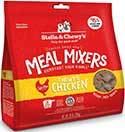
The Stella's & Chewy's Freeze-Dried dog food can be used as a flavor-booster for your dog's standard kibble. The small morsels contain raw chicken and organs, all free of hormones and antibiotics.
Simply sprinkle the food with kibble and your dog's meal will become a palate-pleaser. The food is made up of 48 percent protein and 28 percent fat. In addition to all of the great protein, there's plenty of healthy extras.
Organic fruits and vegetables provide a healthy dose of vitamins and minerals. They also introduce fiber to your dog's diet for good digestive health.
Understanding Your Dog's Eating Habits
Before you start looking for new foods to get your dog eating, it's important that you understand your dog's eating habits.
For a lot of dogs, picky behavior comes out of the blue. They may be eating just fine one day, then refuse to even pick up a piece of kibble the next.
If this happens, pay close attention to how your dog reacts to food around the home. See how they behave when you start eating your own meals. If they flash those puppy-dog eyes, begging for a taste of your food, then they are simply being stubborn.
Many times, this behavior will pass. While it's not ideal, there's no need to worry about your dog skipping a single meal. Sometimes, canines just don't feel like eating. However, if the problem persists, or they don't even blink at the sight of delicious human food, there may be a more pressing issue at hand.
Here are some common appetite issues you may want to consider.
Picky Eating - 8 Appetite Issues
Boredom
Sometimes, the solution for a picky eater is simply switching up the formula. Dogs can easily get bored of eating the same food day in and day out.
They get used to the flavor of their normal food, thus eliminating that excitement that comes from eating. It's not uncommon for pickier canines to reject a formula after only a couple of months of eating it.
The best way to resolve this behavior is to simply invest in a new formula. Many dog food manufacturers offer multiple flavors of food. You can stick with the brand you're comfortable with while providing your dog with something new to chow down on.
Once your dog gets bored with the new flavor, simply move onto something else. You even cycle back to the original flavor after a while and repeat the process. Chances are, your dog won't remember eating that food many months ago.
Alternatively, you can spice up your pup's food with some delicious extras.
Canned food is a great way to get dogs salivating. It's often packed with flavor and produces a stronger aroma than dry kibble. Simply mix it in with the kibble as a tasty treat. Some manufacturers even make flavorful gravies you can pour over dry food.
If you opt to try different formulas and flavors, make sure that you scrutinize the nutritional content of the food beforehand. Just because the food is made by the same manufacturer doesn't mean that it offers the same health benefits.
Bad-Tasting Food
Would you want to continue eating food you didn't like every day? Dogs react to bland foods the same way. But how do you know if the dog food you provide tastes bad? The trick is to examine the ingredients list thoroughly.
Many manufacturers put images of fresh meat on the packaging to advertise a product's given flavor. However, that doesn't mean that those ingredients are actually in the formula.
Some dog foods contain artificial flavors. Essentially, they're a blend of chemicals that are designed to add a boost of flavor to otherwise bland food. Dogs aren't dumb. They know when kibble doesn't taste like real meat.
If you want to ensure that your dog will enjoy the food, make sure that the kibble actually contains the ingredients that the product is supposed to taste like. Real ingredients and natural flavors always trump synthetic alternatives.
Possible Health Concerns
Consult with your vet if your pooch has suddenly lost all interest in food. There are a number of different health issues that could be affecting their appetite. Your veterinary professional can perform a thorough examination to rule out medical conditions.
If there are issues preventing your dog from eating, you can address them so that they start feeling like themselves again.
Dental Pain
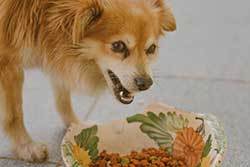
One of the most common causes of a change in appetite is dental pain. Your dog's teeth are not immune to issues from plaque and tartar buildup.
In fact, periodontal disease affects over 80 percent of dogs at some point in their lives. It's a very common issue that can quickly cause decay, infection, and a host of other problems within your dog's body.
Your dog is not going to want to eat if they're suffering from dental issues. Monitor your dog's behavior and look out for tell-tale signs of periodontal disease. These include a strong odor, pawing at the mouth, and excessive yawning.
Luckily, periodontal disease and other dental problems can be treated. Your vet can recommend a course of action, which should resolve the pain and improve your pup's appetite.
Digestive Tract Imbalance
Your dog's gut plays a pivotal role in how they absorb nutrients. It can also affect how they react to food. Your canine companion's digestive tract is filled with beneficial bacteria that keeps everything balanced and healthy.
Unfortunately, imbalances can occur. They can cause stomach pains that range from moderate discomfort to painful cramps.
You may notice that your dog has diarrhea or is throwing up regularly. If that's the case, they may avoid eating to prevent these problems from happening again. It's important that you act fast and get your dog help.
They'll eventually start to lose weight and become malnourished. Vets can provide probiotic treatments to absolve stomach issues.
Allergic Reactions
Some dogs don't react well to certain ingredients in commercially available dog foods. Canine allergies are relatively common. Many breeds are more susceptible to allergic reactions than others.
If your dog consumes something their body doesn't agree with, it can lead to stomach pain and gastrointestinal upsets. Your vet can perform an allergy test to give you a better idea of what is causing the problem. Then, it's all about avoiding that ingredient completely.
Hormonal Changes
Dogs go through many hormonal changes throughout their life. Dogs who are not sterilized are more prone to these types of issues. When female dogs go into heat, their hormones go crazy, causing them to exhibit some strange behavior.
Luckily, pickiness from hormonal changes is not a permanent thing. It will often occur in waves.
Serious Health Complications
While it's not something that dog owners like to even think about, dogs can suffer from serious health issues like cancer. Certain types of cancer can have a drastic effect on appetite.
Tumors may also be the culprit. Your vet will be able to find these problems and determine the next course of action to help your dog.
How to Find A Tasty Dog Food Your Pooch Will Love
Pleasing the palate of a picky pup isn't always easy. Depending on how finicky your dog is, the process may involve some trial and error. To help you find success, here are some things you should keep in mind during your search.
Protein is Key
Dogs thrive on a diet that's rich in protein. While they do occasionally eat plant-based materials in the wild, protein is the main go-to for dogs. The best way to keep your dog happy is to provide them with a diet that's filled with as much protein as possible.
Adult dogs need to consume dog food that's made up of at least 18 percent protein. High percentages are always welcome.
The source of protein is also important. Wholesome protein sources, such as chicken, beef, lamb, and fish are your best bet.
Take a look at the ingredients of your dog food and make sure that an identifiable protein is on the top of the list. This indicates that protein is the most prevalent ingredient in the mix.
Meat meals are another acceptable form of protein, as long as the meat is identified. Good examples would be chicken meal or fish meal. The thing you want to avoid is byproducts, as there's no guarantee of where that protein came from.
Go With Natural Flavors
As mentioned earlier, natural flavors are always better than synthetic ones. You'll often find artificial flavors in cheaper dog foods. It may come in the form of supplements or additives.
Natural flavors come from the ingredients themselves. Take a look at the flavors advertised and make sure that the contents of the kibble match up.
Flavorful Fat
Just like with human foods, fat makes everything taste better. Fat gives dog food an insatiable flavor that your pup want to gobble up.
Healthy fats are also a good source of energy and can provide your dog with a number of health benefits when it's consumed in moderation. There are a couple of acceptable forms of fat.
The best is straight animal fat from the protein source. This mimics the diet of canines in the wild. Some manufacturers will add supplementary fat. However, if the kibble contains high-quality protein sources, it should already have a good dose of fat in it.
The second acceptable fat is oil. More specifically, flaxseed oil and fish oil. These forms of fat offer plenty of flavor. Not only that, but they contain omega fatty acids, which will help keep your dog's skin and fur healthy.
Fiber and Probiotics
While these components don't always add much in terms of taste, they can help your dog avoid stomach issues. Oftentimes, stomach discomfort is the reason for a sudden change in appetite.
By providing your dog with ingredients that promote good digestive health, you can avoid the issue altogether.
Fiber can be found in a wide variety of fruits and vegetables. They're often added to dog food through leafy greens, antioxidant-rich fruits, and complex carbohydrates. Probiotics are healthy bacteria that thrive in the gut.
These ingredients are typically added through supplements. They work to keep your dog's gastrointestinal tract balanced, allowing it to absorb nutrients efficiently.
Related: What's the Best High-Fiber Dog Food?
Steer Clear of Artificial Ingredients and Fillers
Artificial ingredients and unnecessary fillers should be avoided when possible. More budget-friendly foods tend to utilize these ingredients to cut back costs.
Fillers, such as corn, wheat, or soy, don't provide much nutritional value. Instead, they're bland and provide your dog with empty calories.
Artificial ingredients, such as chemical preservatives, colors, and flavors, don't taste all that great. They can also cause some health issues, especially in dogs with allergies. Natural alternatives do exist, so it's best to avoid artificial ingredients altogether.
Conclusion
When your dog starts avoiding their food, you need to take action to keep them healthy. Visit your vet to rule out any health issues and switch to a high-quality food filled with flavorful ingredients.
The goal is to provide your pooch with a meal that they will love to eat every day.
Also Read:

